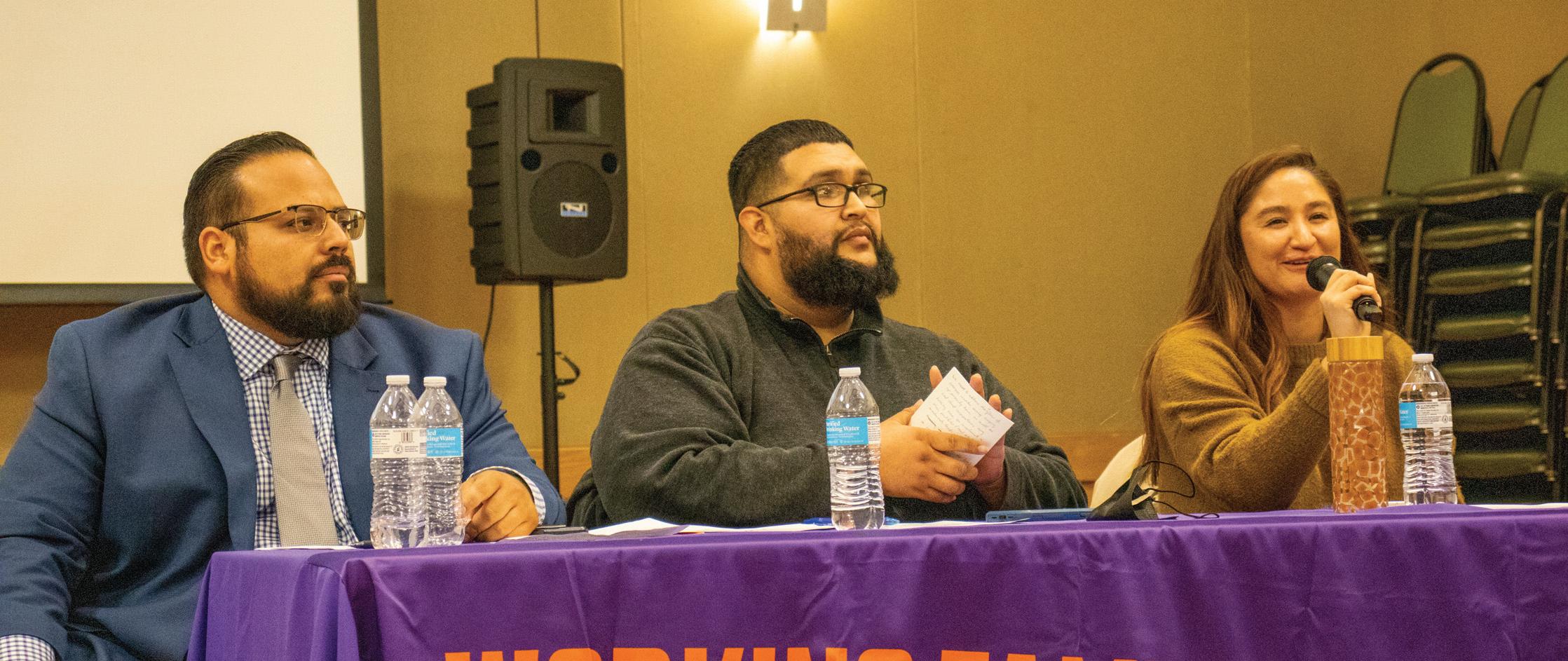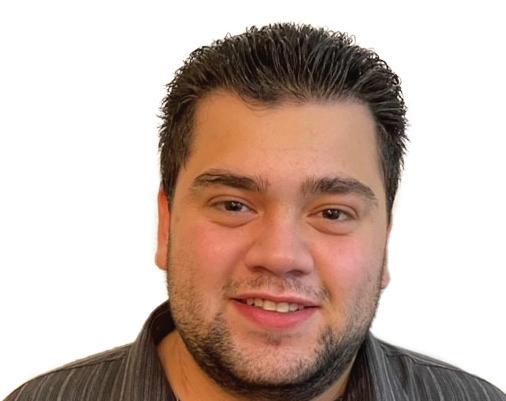Veteran SJSU librarian receives $5,000 award
By Matthew Gonzalez STAFF WRITER
San Jose State librarian, Kathryn Blackmer Reyes was recently honored with the I Love My Librarian award.

The American Library Association awards 10 librarians each year, who receive a $5,000 prize.
The American Library Association is a nonprofit organization in the U.S. that aims to promote libraries and library education, according to the organization’s website.
The award recognizes the accomplishments of school, community college, university and public librarians, according to ilovelibraries, a website for an American Library Association initiative.
Blackmer Reyes said she has worked and stayed at SJSU for 15 years because she believes the stories of the city’s minority population have been undermined.
“San Jose is a really important city, and sometimes I feel that it’s underlooked because of either where it’s positioned geographically – and I think also sometimes the minority population of San Jose is overlooked,” she said.
Blackmer Reyes said interest in showcasing minority struggles has increased as social media has become more prevalent.
“I certainly think the phone with its camera has allowed people to see what’s actually going on out there,” Blackmer Reyes said. “That’s why Black Lives Matter has been so important in our conversation, but we would have never gotten
there if we [had] not seen what happened to George Floyd.”
While also a librarian, Blackmer Reyes serves as the director of the Africana, Asian American, Chicano and Native American Studies Center.
The center covers 6,000 square feet of space on the fifth floor of the Martin Luther King, Jr. Library, the floor contains various collections of literature regarding cultures the center encompasses, according to SJSU scholarworks. Blackmer Reyes said making materials like these available to students is a good supplement to the curriculum being taught at the university, and can help inspire change toward a campus that is more sensitive to cultural diversity.
“We want work that is happening in Chicano studies and African American studies [and] Asian American studies to be appreciated,” Blackmer Reyes said. “It’s not just teaching, it’s working with students that are being challenged by the academy, by being in the university.”
Blackmer Reyes said there are aspects of librarianship she feels are overshadowed by people’s preconceptions of the job.
Librarianship is a profession concerned with collecting and arranging books and similar materials in libraries and providing these resources to readers, according to dictionary.com.
“What makes a good librarian, or what’s not understood in this sort of reference question, is that it really is just a conversation with the
SJSU lab makes waves in marine biology research
By Dominique Huber STAFF WRITER

Researchers and students at San Jose State’s Moss Landing Marine Laboratories have the opportunity to help in the recovery of the Olympia oyster population and researching emperor penguins in Antarctica, among many other projects relating to marine biology.
Moss Landing Marine Laboratories, located about 90 minutes south of campus in Moss Landing, Calif., is a marine science research and education facility, overseen and primarily funded by SJSU.
Multiple universities from the CSU system, including San Francisco, Stanislaus, East Bay, Fresno, Monterey Bay and Sacramento, participate in the lab and contribute funding and faculty members.
“Having a lot of different expertise allows us to explore the oceans and
Calif., according to the same webpage.

For nine years, the lab operated out of trailers in a lot neighboring a cemetery and a chocolate factory while its new facilities were constructed, according to a blog post on SJSU’s MLML webpage.
“Now we have this state of the art, beautiful building up on the hill,” Aiello said.
He said after the rebuild, the lab expanded to include a marina, a wharf, a shore lab facility and other features that make it a “selfsustaining campus.”
Moss Landing Marine Laboratories is partially made up of eight faculty labs, including biological oceanography, chemical oceanography, geological oceanography, ichthyology, which is the study of fishes, invertebrate ecology, phycology, physical oceanography and vertebrate ecology, according to the labs website.
understand the effects of global climate change in a much more effective way,” said Ivano Aiello, interim director of Moss Landing Marine Laboratories.

SJSU bought the facility for Moss Landing Marine Laboratories in 1965 for $210,000, according to the university’s History of Moss Landing Marine Laboratories webpage.
The 1989 Loma Prieta earthquake destroyed most of the facility’s buildings, resulting in the transportation of most of the equipment to trailers in Salinas,
The lab is also partnered with a number of groups outside the CSU system.
Some of these groups include the Western Association of Marine Laboratories, the UniversityNational Oceanographic Laboratory System and the Consortium for Ocean Leadership, according to its affiliations webpage.
“These other groups extend the range of topics and research opportunities, education
Volume 160 No. 25 Thursday, March 23, 2023 SERVING SAN JOSE STATE UNIVERSITY SINCE 1934 WWW.SJSUNEWS.COM/SPARTAN_DAILY NAMED BEST CAMPUS NEWSPAPER IN CALIFORNIA FOR 2022 BY THE CALIFORNIA COLLEGE MEDIA ASSOCIATION
INFOGRAPHIC BY VANESSA TRAN SOURCES: NBC BAY AREA, SAN FRANCISCO CHRONICLE, ABC7
RAINIER DE FORT-MENARES | SPARTAN DAILY
Librarian Kathryn Blackmer Reyes speaks to the press at the Martin Luther King, Jr. Library on March 16.
Having a lot of different expertise allows us to explore the oceans and understand the effects of global climate change in a much more effective way.
AWARD | Page 3 MOSS LANDING | Page 2
Ivano Aiello interim director Moss Landing Marine Laboratories
MOSS LANDING
Continued from page 1
opportunities that we offer here,” Aiello said.
One of Moss Landing Marine Laboratories’ primary functions is to administer the Master of Science in marine science, according to the lab’s about Moss Landing Marine Laboratories webpage.

Graduate students from CSU universities in northern and central California go to Moss Landing Marine Laboratories to work with faculty members and researchers to get research experience.

Jacob Harris, marine science master’s student at Moss Landing Marine Laboratories, said he appreciates the hands-on approach that the lab encourages.

He said he is working with a team that is attempting to recover the depleting Olympia oyster population at Elkhorn Slough, an estuary commonly studied at Moss Landing Marine Laboratories.
“I feel like I’m doing what I’ve been working toward,” Harris said. “I really got to shape my own project. I really got to make my own goals and design my program in a way that I’m getting what I want out of it.”
Tom Connolly, associate professor of physical oceanography at Moss Landing Marine Laboratories, said the relationships formed between faculty members and graduate students during research projects are mutually beneficial.
“Being able to work with a graduate student who’s working on a focused master’s thesis, that’s really diving into detail, is a really valuable part of our job,” Connolly said.
Aiello said there are many advantages to the presence of graduate students at the lab.
“The fact that many of my colleagues are so successful in their research is because they do work with grad students, absolutely,” he said.
Sydney McDermott, marine biology graduate student and student assistant at Moss Landing Marine Laboratories, said the lab connects students to excellent resources.
McDermott, who completed her undergraduate in Maine, said she was extremely interested in the lab because of its “stellar reputation” as a marine science graduate school.
Currently in the last year of her master’s, she said she is focused on her thesis on researching the impacts of shipping containers that are lost in the deep sea, and the marine life communities that form because of them.
The lab has around 95 students, according to McDermott, and around 77 faculty, staff and research affiliates, according to the lab’s staff directory.
McDermott said this kind of diversity within a relatively small group makes for a very pleasant atmosphere.
“It’s a very tightly knit community and everyone’s doing all of this incredible science and it’s not isolating to do something super different than everyone else,” she said. “It’s so wonderful, the kind of spirit of camaraderie and collaboration here.”
McDermott said she recently accepted an out-of-state PhD position for the fall.
She said her time at Moss Landing Marine Laboratories showed her that she is on the right path and would like to continue her research on the impacts humans have on the ocean.
Many of the lab’s last 238 graduates went to PhD programs or obtained employment in universities, environmental agencies or nonprofits, according to SJSU’s Moss Landing Marine Laboratories master’s program webpage.
“We’re creating a new workforce for the future challenges of the planet,” Aiello said. “We’re providing a pipeline of highly skilled marine scientists in the workforce.”
Moss Landing Marine Laboratories has three main avenues for funding according to the lab’s 2019-2020 Annual Report.
One comes from SJSU, the second from the SJSU Research Foundation and the third from a wide array of donors outside the CSU system.
SJSU’s College of Science provides the lab with a budget every year, according to the same report.
With this budget, the laboratory pays for the salaries of all faculty and staff, as well as equipment and operations of the main lab.
The SJSU Research Foundation also helps plan, fund and manage the university’s research projects, according to its webpage.
It gives a percentage of each of the grants it receives to Moss Landing Marine Laboratories, according to the same annual report.

In addition, federal and state grants, nonprofit donations and private donors make up the rest of the funding for the lab.
Aiello said with this money, faculty at the lab can buy equipment and hire students and technicians for their projects.
He also said there are advantages to having such a diverse set of faculty, researchers and students associated with Moss Landing Marine Laboratories.
“Our students get exposed to a network of expertise and opportunities which is very broad, even beyond SJSU,” Aiello said. “Many of our students have job opportunities or academic opportunities that are unique.”
Along with its eight faculty labs and 10 partner groups, Moss Landing Marine Laboratories has 15 affiliated labs.

These laboratories are dedicated to specific topics of research such as wetland science, environmental biotechnology and research diving, among others.
Aiello said the wide range of topics explored at the lab increases the quality of the work they do.
Connolly said, as a scientist and educator, he has a special appreciation for the varied people and projects at Moss Landing Marine Laboratories.
“Diversity is really essential for developing new ideas,” Connolly said. “As a faculty member, I still get to learn about new things by working with people who specialize in different areas of science, so I feel really lucky in that respect.”
He said one thing most people at SJSU don’t realize about the lab is that undergraduate students are welcome to take classes there and get involved in research projects, even if they don’t have a background in marine biology.
“I studied engineering as an undergraduate,” Connolly said. “I think there’s a lot of students in those types of fields that might not realize that oceanography or environmental science is an option for them.”
McDermott said the Moss Landing Marine Laboratories will host an open house event on April 22, its first open house in person since the start of the pandemic.
The annual event is meant to raise money for student research projects, according to the
webpage for 2022’s virtual open house.
The different labs within Moss Landing Marine Laboratories host educational activities and set up tables to display the research they’ve been working on, according to the same webpage.
“It’s really beautiful here and everyone should come take a look if they have the opportunity,” McDermott said.
Aiello said he has high hopes for the future of Moss Landing Marine Laboratories.
He said he predicts that a lot of their work will continue efforts toward understanding the effects of climate change and finding potential solutions.
“I think that in the next 10 years, we’re gonna be able to step up on the level of education and skills that the students who come to this program will acquire on topics that are gonna be fundamental for the survival of our species,” Aiello said.
sjsunews.com/spartan_daily THURSDAY, MARCH 23, 2023 NEWS 2
Marine biology graduate student Sydney
works on a block of artificial
for her thesis work at
Follow the Spartan Daily on Twitter @SpartanDaily
McDermott
substrate
Moss Landing Marine Laboratories.
PHOTOS COURTESY OF IVANO AIELLO
(Top) Maxime Grand, chemical oceanography assistant professor at Moss Landing Marine Laboratories, samples for nutrients with his students in the Elkhorn Slough, an estuary commonly studied at Moss Landing Marine
OF IVANO AIELLO
Laboratories(Left) Sea lions spotted sunbathing on a pier by students doing field work at Elkhorn Slough. (Right) A swimming otter spotted by students doing fieldwork at Elkhorn Slough. PHOTOS COURTESY
World Water Day splashes into Hammer Theatre
By Brandon Nicolas STAFF WRITER
San Jose State Art and Art History and Environmental Studies departments collaborated to create the “Hidden Life of Water,” to celebrate the United Nations’ World Water Day 2023.
The event explores current event topics regarding rainfall and climate change with a panel of speakers, poetry and informative performances at the Hammer Theatre on Wednesday.
The first program had panelists expertizing in either environmental studies or sustainability, discussing water-related events ranging from drought to atmospheric rivers.

The three speakers were environmental studies associate professor Katherine Cushing; environmental associate professor Constanza Rampini; and Senior Sustainability Program Lead of the Office of Sustainability Debbie Andres.
Cushing said the average annual rainfall in California is 22 inches, but during the last drought cycle, the average rainfall doubled.
“Our last two drought cycles happened pretty close together,” Cushing said. “One was between 2012 and 2015, and over these last few years.”
Cushing said the drought between 2012 and 2015 and the recent drought California has been in for the past years occurred close together.
She said California residents are primarily concerned with droughts because some of the state’s hottest years have been in the past decade.
“When you think about a phenomena like climate change, there is more energy in the atmosphere – water that used to be near the surface that evaporates,” Cushing said. “More energy in the atmosphere leads to a greater frequency of extreme events like droughts and floods.”
Cushing said, in a matter of five months, a majority of California went from being in the worst stages of a drought to experiencing the opposite.
She said floods are the opposite of droughts – unexpected overflows of water where land is usually dry.
AWARD
Continued from page 1
“Before this water season, the 2017 President’s Day flood was the costliest flood in Santa Clara County history,” Cushing said.
The 2017 President’s Day floods were “two back-toback atmospheric river storms in mid-to-late February . . . the storms arrived a week after heavy rainfall in Northern California prompted the evacuation of nearly 200,000 people when flooding damaged both spillways of the Oroville Dam,” according to an Oct. 5, 2021 article from Climate Signals, a non-profit that curates climate change attribution.
The new rainfall records included San Jose at 1.87 inches, San Francisco International Airport at 2.16 inches and Sacramento at 1.74 inches, according to the same article.
She said the cost of the 2017 President’s Day flood was estimated to be $100 million in damages, which is only a fraction of the billions of dollars in damages from rainstorms today.
An atmospheric river is a flowing column of condensed water vapor in the atmosphere responsible for producing significant levels of rain and
patron or student, in many senses I don’t like the term ‘patron,’ ” Blackmer Reyes said. “It’s just talking and figuring it out, and trying to provide the best tool for the need rather than just giving the product.”
Senior assistant librarian Adriana Poo said she has sporadically worked with Blackmer Reyes during her tenure at MLK Library.
She said it’s inspiring to see the dedication Blackmer Reyes puts into her collections, and believes her work taps into a greater call for change.
“She’ll go out into the community and she’ll make connections and she’ll bring community members in to share what they’re doing,” Poo said.
snow, according to the National Oceanic and Atmospheric Administration.
Cushing said these pathways of water vapor are more directed and concentrated.
“Sometimes it feels like it’s raining buckets – the rain is so strong,” she said. “It’s because we are having more [of] these atmospheric rivers as opposed to regular precipitation events.”
The strength of winds and rain have caused power outages across the Bay Area, impacting SJSU last week.
“We have all been through a lot in the past few weeks,” Rampini said. “I was out of power for the last full day –without internet all of today.”
She said, despite the negative impact the storms had on Santa Clara County, it’s important to recognize that California is no longer in a drought.
“All of our reservoirs right now are above their historical average,” Rampini said. “They aren’t necessarily full, but they are breaking records and that’s great.”
The Oroville Dam, which was damaged by the 2017 floods, has recently been fixed to minimize overflowing streams.
“I think it’s about the width of about 15 highway lanes,”
Poo said one of Blackmer Reyes’ strongest abilities is having the community share different aspects of their culture in the form of library exhibits.
She said Blackmer Reyes’ fundraising for the fifth floor makes her work invaluable and isn’t a responsibility shared by all librarians.
“She also has to be in charge of fundraising for her center, but she is so passionate and I think her passion has allowed her to be in unique spaces and meet very unique people, and through her passion [people] have opened up their collections to Kathy,” Poo said.
Senior assistant librarian Estella Inda said she has worked closely with Kathryn since she became a librarian for SJSU.
Inda previously worked as a librarian for the general San Jose Public Library for 18 years before switching to her current position.
Rampini said. “Just 12 days ago, the dam released water for the first time in years to make room for the floods we are having now.”
Rampini said, in addition to the resources dams provide like electricity and flood protection, in case the reservoir level was lowered ahead of an upcoming flood, there will be more room to hold the rain that would otherwise destroy communities downstream.
“It’s not abnormal – California always swings between droughts and atmospheric rivers,” Rampini said. “What we are seeing is that these events are being more extreme.”
She said many people in San Jose downtown and at SJSU do not realize there are two rivers near campus, Coyote Creek and Guadalupe River.
“These communities are living along the river banks, near our river banks and sometimes in the river beds themselves,” Rampini said. “Our homeless community members are really the ones who cannot protect themselves from floods, droughts and heatwaves.”
She said it’s the people living the closest to the river who experience these extreme weather conditions the most.
She said Blackmer Reyes has been a mentor-like figure for her as she navigates her new responsibilities.
“Her knowledge is impeccable, through her I learned the importance of making community connections, keeping those community connections, [and] using the community as a resource has been very vital to my own projects,” Inda said. “Guidance wise I can’t even say how much stuff I’ve learned from her.”
Inda said viewing Blackmer Reyes as an adviser is not a sentiment shared solely by her.
She said many librarians at MLK Library have been inspired by her work and the way in which she runs her center.
“I learned to elaborate further because of Kathy, she’s helped inspire a lot of us, she mentors many of us,” Inda said.
She said Blackmer Reyes has grown
“We’ve done everything to hide our rivers from our view – we have cemented their channel, connected them with each other and poured cement all over,” Rampini said. “We’ve seen so much urbanization in this area that used to be called, ‘The Valley of Heart’s Delight.’ ”
She said because San Jose has so many impervious surfaces, all the rainfall enters the river channels at once instead of trickling down to the ground water.
“We’ve seen a lot of rain and we are probably thinking, ‘Conservation isn’t that important,’ but we will always have a drought and we will always have rain,” Debbie Andres said. “Both of those events will get more and more extreme.”
Andres said the main water conservation strategy at SJSU is to use recycled water.
“When you flush your toilets or use the sink or wash your clothes, all of that water goes to the South Bay Recycling Water Facility,” she said. “Historically, that water would go to the bay, but it gets treated at the facility.” Andres said recycled water can be also used for irrigation, flushing toilets and golf courses.
“Instead of pulling from our reservoirs, our water use is mostly from underground sources,” she said.
Andres said the first way SJSU started to conserve water was the creation of a cooling tower in 2001 that uses recycled water. She said it saves nearly 16 million gallons of water per year.
The latest system that was converted to a recycled water system was the implementation of dual plumbing.
“Dual plumbing means there is two plumbing systems in each building,” Andres said. “One is the water that goes to your sinks and your showers, and the other one goes to our toilets.”
She said starting with Dr. Martin Luther King, Jr. Library, toilets were flushed with recycled water and double plumbing was installed in each of the buildings that followed.
“We save over 100 million gallons of water a year, and we use more recycled water than fresh water,” Andres said.
the Africana, Asian American, Chicano and Native American Studies Center into something spectacular.
Senior assistant librarian Anne Marie Engelsen said Blackmer Reyes’ recognition was long overdue and her work is indispensable to everyone.
“The work that Kathy does is making sure that in the future our history, our current lives are not going to be told just from one viewpoint,” Engelsen said. “I’m so proud of her, I’m so happy that she won that award and I just feel it was a long time coming and I’m just glad it finally happened.”
Follow Matthew Gonzalez on Twitter @demenares
sjsunews.com/spartan_daily THURSDAY, MARCH 23, 2023 NEWS 3
BRANDON NICOLAS | SPARTAN DAILY
(Left to right) Dr. Katherine Cushing, Dr. Constanza Rampini and Debbie Andres celebrate United Nations’ World Water Day with a panel discussion at the Hammer Theatre on Wednesday afternoon.
EDITORIAL STAFF EXECUTIVE EDITOR NATHAN CANILAO MANAGING EDITOR ALESSIO CAVALCA ASSOCIATE EDITOR BOJANA CVIJIC PRODUCTION EDITOR CAROLYN BROWN NEWS EDITOR RAINIER DE FORT-MENARES A&E EDITOR VANESSA TRAN OPINION EDITOR JILLIAN DARNELL CONTACT US EDITORIAL –MAIN TELEPHONE: (408) 924-3821 EMAIL: spartandaily@gmail.com ADVERTISING –TELEPHONE: 408-924-3240 ADVERTISING STAFF ADVERTISING DIRECTOR MIA WICKS CREATIVE DIRECTOR BRIANNE BADIOLA ABOUT The Spartan Daily prides itself on being the San Jose State community’s top news source. New issues are published every Tuesday, Wednesday and Thursday throughout the academic year and online content updated daily. The Spartan Daily is written and published by San Jose State students as an expression of their First Amendment rights. Reader feedback may be submitted as letters to the editor or online comments. SOCIAL MEDIA EDITOR BRYANNA BARTLETT PHOTO EDITOR ALEXIA FREDERICKSON COPY EDITORS CHRISTOPHER NGUYEN HAILEY FARGO GRAPHICS EDITORS HANNAH GREGORIC JANANI JAGANNATHAN MYENN RAHNOMA SENIOR STAFF WRITERS ADRIAN PEREDA JEREMY MARTIN OSCAR FRIAS-RIVERA STAFF WRITERS ALINA TA BRANDON NICOLAS CHRISTINE TRAN DYLAN NEWMAN DOMINIQUE HUBER ENRIQUE GUTIERREZ-SEVILLA MAT BEJARANO MATTHEW GONZALEZ PRODUCTION CHIEF MIKE CORPOS NEWS ADVISER RICHARD CRAIG EMAIL: spartandailyadvertising@gmail.com CORRECTIONS POLICY The Spartan Daily corrects all significant errors that are brought to our attention. If you suspect we have made such an error, please send an email to spartandaily@gmail.com. EDITORIAL POLICY Columns are the opinion of individual writers and not that of the Spartan Daily. Editorials reflect the majority opinion of the Editorial Board, which is made up of student editors. Follow the Spartan Daily on Twitter @SpartanDaily
SJ community weighs in on rent issues
By Mat Bejarano STAFF WRITER
San Jose council member Peter Ortiz collaborated with local organizations, SOMOS Mayfair and Working Partnerships USA, and organized “The Affordable Housing Town Hall” on Wednesday at Mayfair Community Center.
The event focused the attention on plans the organizations have to address issues related to housing and rent in San Jose.
In addition to Ortiz, the event showcased two other panelists: Huascar Castro, the associate director of housing and transportation policy at Working Partnerships USA and Andrea Portillo, director of community organizing and policy at SOMOS Mayfair.

During the event, the three speakers discussed the importance of tenant’s legal representation and projects related to affordable housing with members of the community.
Castro, who talked about tenant protection, said it’s extremely important for San Jose renters to have protection in cases of evictions.
“Just in that alone, by allowing a higher percentage of tenants to have representation through the eviction proceedings, we are allowing jurisdiction and ultimately reduce displacement which has been identified as a major goal for the city,” Castro said.
He also said Working Partnerships USA is taking steps toward building tenant’s legal representation, including the right to counsel.
“A Right to counsel works similarly to when someone is arrested and has a right to being represented, by ensuring anyone facing eviction has the right to legal representation,” Ortiz said.
Castro said by allowing a right to counsel, the city will ultimately save money because those who are given legal representation will not need access to other social services.
“Study shows us, for a little more context, that this return could be as high as $12 for every $1 invested in the right to counsel
program,” Castro said to the audience.
Renters in San Jose must now earn $54 an hour in order to afford the average monthly rent for a two-bedroom apartment according to a May 16 ,2022 County of Santa Clara article.
Castro said allowing tenants to receive legal representation balances the playing field.
“[Tenants] are having to deal with the traumas of facing eviction and they’re the ones in court facing housing insecurity,“ Castro said. “Add to the layer that they don’t have legal representation and that the landlord has a private market fully funded attorney ready to do all of their bidding.”
San Jose is currently the second most expensive city to rent in with a median rent price of $2,502 a month according to a Feb. 21 Earnest study.
“An ACLU [American Civil Liberties Union] study showed that landlords come to court with a lawyer 92% of the time, but tenants only have legal representation 2% of the time,” Ortiz said.
Ortiz also spotlighted the importance of the Community Opportunity to Purchase Act (COPA), which gives qualified nonprofit organizations the right of first offer and/or the right of first refusal to purchase
certain properties offered for sale in the City, according to its website.
“COPA is the strategy that we’re going to use to combat displacement in East San Jose,” Ortiz said. “My district five has been designated as an area that’s extremely vulnerable to displacement, so it’s important for my residents and to the voters and to the voters of my district.
Portillo, who was the second speaker of the night, also remarked on the importance of COPA.
“The goal again is a preservation policy, and so by having qualified nonprofits who share the same values, who value tenant engagement and ownership and education and value anti-displacement work and see the value in that,” Portillo said. “[Nonprofit organizations] will be able to purchase the property so that tenants can remain in their homes long term.”
In San Jose, 7.7% of people were living in poverty in 2021, according to the census.gov
Portillo said it’s important to prioritize very low and extremely low income tenants.
“This policy has been very contentious, there’s a lot of opposition, mainly from realtors associations and pro for-profit developers,” Portillo said. “It’s really
important that we have a council member that’s championing this that can help us move it in the avenues that he can.”
Organizations are working to provide housing and legal representation for tenants, but the Silicon Valley tech industry still plays an important role in this issue.
Portillo said tech companies may generate displacement into communities.
“The market shifts, the types of housing that they build are not meant for our very low, extremely low income folks,” Portillo said. “So it definitely does have an impact on the levels of displacement that we see for the community.”
Ortiz said, although he supports tech companies, they should complement their expansion providing resources to the neighborhoods.
“I think the way it’s growing, the way Silicon Valley is growing, it’s not taking into consideration the people who currently live here, especially working people in East San Jose. They are not investing in our local school districts,” Ortiz said.
Follow the Spartan Daily on Twitter @SpartanDaily
A.S. board debates on SWANA resolution
By Dylan Newman STAFF WRITER
The Associated Students board held a meeting Wednesday afternoon where they discussed a resolution to call upon the university in the form of a letter to establish a group for Southwest Asian and North African students (SWANA).
The meeting resulted in a heated discussion between members of SWANA and advocates for Jewish students to be under the SWANA umbrella.
SWANA is comprised of students that are seeking representation from the demographic region of what’s eurocentrically known as the “Middle East.” “SWANA” is also a term used to describe that region.
The resolution allows the group to draft a letter to San Jose State to achieve recognition as a group and potentially create a dedicated space for SWANA members on campus.
A member of the public forum named Liz, whose last name was not given, spoke on Zoom at the beginning of the meeting, bringing up a Feb. 22 opinion article published by the Spartan Daily about how SWANA students need more representation on campus. She said the article had “a calculated and deliberate exclusion of Jewish students,” referencing the map on the article showing Palestine and not Israel, insinuating members of SWANA were making steps to exclude this demographic of people.
Forensic biology senior and member of the SWANA project, Maryam Moshref, was quick to elaborate on Liz’s comment.
“[The author of the Spartan Daily Article] wanted me to also present to you guys that [Jewish and Israeli students] are more than welcome to be part of SWANA as well as having that safe space to be opened up toward them because they are part of the region,” Moshref said. “We didn’t deliberately separate them because of Palestine, so we just wanted to clarify that.”
The action item on the agenda was named “Letter of Support for SWANA,” which was a motion that quickly derailed into a tense backand-forth about the inclusion of Israeli and Jewish students under SWANA.
The A.S. Director of Student Affairs Magnus Herrlin said in the one month of SWANA’s deliberations, no one within SWANA tried to
contact Jewish or Israeli students and claimed this was a anti-Zionist and antisemitic move by SWANA.
“The SWANA group and the SWANA project has been around for roughly a month right now on campus, and in no time did that in that month did they seek to reach out to our Jewish and Israeli brothers and sisters who are on campus.” Herrlin said. “Moreover, I think this demonstrates a kind of pattern of antiZionism and antisemitism that has that these two groups have experienced on this campus.”
Before proposing an amendment to the SWANA letter, he referenced an alleged comment made by a separate group on campus that claimed House of Representatives member Ro Khanna was a white supremacist and was working with Israeli arms dealers.
Herrlin pulled up a photo of Khanna and said, “Does this look like a white supremacist to you?”
Herrlin’s first amendment was to add a commitment to the SWANA letter that allows students who support Israel to be included in SWANA and all future conversations about it.
Fatema Balkhi, forensic biology student and member of the SWANA project said SWANA is not a religious group on campus, and that SWANA is about demographics.

“[SWANA is] for people who like our demographic, and identify as such and want to come and advocate for their own, like whatever they want to advocate for,” Balkhi said. “For example, Afghans can come and advocate for issues in Afghanistan, Iranians can come and advocate for issues in Iran, and since Justice in Palestine can come and advocate for their issues, the Israeli club can advocate for their issues.”
A member of the Jewish Student Union, Michael, whose last name was not given, spoke during the meeting saying he initially saw the Spartan Daily article as SWANA excluding Jewish community members.
He came to understand how this wasn’t the case after Balkhi and Moshref’s clarifications.
After an hour of back and forth conversation about the amendment, A.S. director of intercultural affairs Luis Aquino had to step in to remind everyone that this wasn’t a place to point fingers, and a clear miscommunication because of the focus on the map in the referenced Spartan Daily article.
Herrlin then called upon the board to condemn antisemitism and claimed the board failed to condemn anti-Zionism.
Anti-Zionism is the opposition to the establishment or the support of the modern nation state of Israel, according to an April 28, 2016 BBC News article.
Anti-Zionism can be erroneously conflated with antisemitism, which is hostility and prejudice towards Jewish people, while anti-Zionism critiques the actions of the Israeli government, according to the BBC News article.
When nobody seconded Herrlin’s proposal or his second proposed amendment to add the Jewish Student Union to SWANA, he accused the board of being anti-Zionist and antisemitic.
“Director Nikalwala has said you know our actions speak louder than words.” Herrlin said. “Clearly this board has antisemitism and anti-Zionism.”
A.S. President Nina Chuang swiftly interrupted the accusation by pounding her name tag down, immediately calling for a point of order after his comment.
She commended the members for advocating for their respective communities and the conversation was about a center for SWANA students.
Balkhi said that semitic languages span the demographic area they are discussing, she was also disgusted at being called antisemitic while trying to give voices to semitic people.
“Palestinians are semitic, Arabs are semitic,”
Balkhi said. “The word ‘semitic’ actually does not explicitly focus on an ethnic demographic, it focuses on the demographic of regions in which a language is spoken, Arabic is a semitic language, Hebrew is a semitic language.”
Balkhi defended her group’s position and advocacy to create a SWANA group on campus for students who are part of the Southwest Asian and North African communities.
“It is insulting to call the people here [antisemitic] who are trying to give voices to semitic people who are considered a large portion of the SWANA demographic.” Balkhi said. “To say ‘antisemitism’ is insulting, it’s disgusting.”
Bytheendofthelongback-and-forthbetween nearly the entire board and students, the motion to add the amendments failed, and SWANA was granted the ability to create the letter to the university.
Chuang, after the meeting, explained more about the letter.
“This letter not only tells [the] university, ‘hey, we want the space but also educates anyone who’s reading it about our history here.’ ” Chuang said. “But for us at San Jose State, we need to really help recognize and amplify these voices so that everyone has a seat at the table.”
sjsunews.com/spartan_daily THURSDAY, MARCH 23, 2023 NEWS 4
MAT BEJARANO | SPARTAN DAILY
DYLAN NEWMAN | SPARTAN DAILY
Fatema Balkhi (left) and Mariam Moshref (right) address the resolution of SWANA during a meeting in front of the Associated Students board of directors on Wednesday at the Student Union.
FollowDylan
on Twitter @th3dylanproject
Newman
From left to right, Peter Ortiz, Huascar Castro and Andrea Portillo discuss and housing and renting issues with the San Jose community at the Affordable Housing Town hall event on Wednesday at Mayfair Community Center.
WOMEN’S TRACK
Sjostrand receives conference honors
By Christine Tran STAFF WRITER
San Jose State sophomore jumper, Emilia Sjostrand, was announced as the 2023 Mountain West Co-Women’s Indoor Track and Field Student-Athlete of the Year on Wednesday afternoon.

The title is given to the best male and female studentathletes for their indoor season in the Conference, according to the Mountain West website.
“It’s definitely a special award to get,” Sjostrand said. “It kind of summarizes the whole season and shows that I was consistent all the way through.”
Sjostrand is now the first student-athlete from SJSU to win this honor, after she finished seventh in the nation for the NCAA Indoor Championships Women’s Triple Jump. She also holds the school record for Women’s Long Jump with a mark of 6.48 meters.
Sjostrand is currently the best jumper in the history of Sweden, her home country, for the Triple Jump mark with a personal best record of 13.98m.
Charles Ryan, director of track & field, has 14 years of NCAA coaching experience.
Ryan said Sjostrand
receiving the award is special, and a huge deal for her and the SJSU Track and Field program as a whole.
“Emilia is well deserving of that award and, you know, we’re extremely proud of the work that she’s put in this year,” Ryan said. “She’s the best athlete on our team right now and the leader . . . so we couldn’t be prouder.”
Off the track, Ryan said Sjostrand is still quick on her feet with a great sense of humor.
“I enjoy social banter time with Emilia because she is so smart and her sense of humor kind of matches mine,” Ryan said. “She’s just what you want a student athlete, at the collegiate level, to be.”
Sjostrand was also named Mountain West Women’s Field Athlete of the Week this week after she competed at the Cardinal Classic at Stanford University.
She took first place on Saturday in the Women’s Triple Jump with a mark of 13.92.
Ryan says Sjostrand is a leader because of her attention to detail and passion for honing her craft and being good at it.
“[Emilia] has well over a 3.0 GPA,” Ryan said. “She’s at practice every day, she does not miss, she doesn’t take day off [and] she goes hard
in the weight room. If I can get 10 versions of Emilia on the women’s team, we win the national championship.”
Ryan said Sjostrand has been on the Women’s Track and Field roster since last January and instantly made a difference for the team.
He said she wasn’t ready for that level of competition in the NCAA preliminary round, but now she is one of
the best in the nation.
“There’s really no ceiling on what Emilia can’t do in the sport,” Ryan said. “I fully expect her to be an All-American outdoors, potentially in more than one event [this year]. I expect her to be competing this summer, representing her national team for Sweden or straight up at the FTC championships in Budapest this year.”
Ryan said Sjostrand is talented enough to accomplish all of those things, and it can ultimately lead to competing as an Olympian in 2024.
“There’s really nothing holding her back,” Ryan said regarding her future as an Olympian. “All she has to do is continue to work the way that she does and stay healthy, and she could do whatever she wants in the sport.”
Sjostrand said she wants to build on the success from this season when she laces up her track shoes outdoors.
“For outdoors, I would like to win the conference again in long jump and triple jump,” she said.
Lady Spartans look to win National Championship
By Alina Ta STAFF WRITER
The San Jose State women’s rugby team is always ready to tackle the competition with strategy and team spirit.

The rugby team is an all-female and student-run club sports team, competing for the National Collegiate Rugby Championship trophy in April.
“[They’ve been] building it up, and we’ve had some really good success lately,” said James Fonda, the team’s head coach.
Fonda said after the restrictions for COVID-19 were lifted, the team came back together and had an undefeated preseason, before winning the West Coast Conference in 2022.
He said winning the conference made them the number one team in their region.
This includes competing against numerous schools like California Polytechnic State University, University of California, Santa Cruz, Santa Clara University, University of Nevada, Reno and more.
Communications disorders and sciences senior Meghana Narravula, the team’s president, said winning the conference gave them the opportunity to compete in the national championship in Atlanta, Georgia.
She said it was crazy and fun when they were competing in nationals, even though her cleats melted from standing and walking on the hot turf in Atlanta.
Narravula and Fonda said the team continued to practice rugby during the COVID-19 restrictions to keep in shape.
Fonda said it was difficult for some of the players because a number of them
went back home and left the Bay Area, but the rest of the team was still able to meet up.
He added he felt it was important for the team to keep meeting up because he noticed the team’s morale was decreasing.
“We would go ahead and try to get an hour’s practice . . . and that just, you know, made their day,” Fonda said.
Narravula said the practices during the COVID19 restrictions helped keep the team members close and bonded with one another.
“I think honestly, [our relationships] grew stronger [during the COVID-19 restrictions],” she said.
Biomedical engineering senior Aimee Ramos said the team was recently revived between 2016 and 2017.
She said when she first joined the team, the players were not playing in major conferences or championships.
However, Ramos said
Fonda, who was previously a coach for a men’s team.
Ramos said after hiring coach Fonda, the team signed up for its first rugby competition: the West Coast Conference.
“We got into a conference and kind of just been, like, on the rise since then,” she said.
Fonda said when he first took over the program, there were barely enough players to fill the team.
He said after the players started doing more recruiting, the team grew.
Ramos said the team now continues to have a strong sense of community.
then after it’s very much respectful, like, everyone talks to each other,” she said.
Murnane said she always tells people to join the team if they want to make new friends in a diverse group.
“This is, like, the family basically for me,” she said.
Narravula said though the sport looks “rough and tough” on the field there is still respect between different teams.
“We’ll leave it on the field . . . We’ll tackle you, we’ll help you up afterwards and then, like, we’ll go hang out,” she said.
Joireen Orcine said it was scary to join the team at first, but now she loves the team’s energy.
“I never, like, once felt, you know, out of place,” Orcine said.
Orcine said her teammates always made her feel welcomed, and she never feels uncomfortable making mistakes when they are together.
“It just made it easier to learn everything,” Orcine said.
out of her hometown of Claremont, California, and then moved to San Jose on her own when she was 17.
She said in her hometown, she remembered seeing people play a similar sport known as powder puff football, but girls were not allowed to join the sport.
After coming to SJSU, Tang said she considered joining the wrestling team, but decided to try a new sport.
at the end of her first year on the team, she, along with some of the team’s previous leadership, decided they wanted to compete and eventually signed up for conferences.
She said the team received the opportunity to compete when they reached out to
“If you were to show up to practice or even just a game, like, you’ll get the sense of community just being there,” Ramos said. “It’s very lively, everybody talks to each other.”
Forensics science senior Lindsey Murnane, who is also the team’s captain, said she feels the sport carries a sense of respect, even between teams on the field.
“It’s, like, competitive but
Ramos said rugby is a competitive sport, but not to the point where players put each other down.
“Yeah, you lose . . . on the field, but then afterwards, you’re going out for a bite to eat and, ‘Oh my gosh, that was such a great hit when you knocked me out almost,’ ” Ramos said. “I think everybody can agree it’s one of the biggest, most like, coolest things [about] rugby.”
Kinesiology freshman
Film freshman Moana Faleofa said she first discovered the team on Instagram when she was still playing for her highschool’s rugby team in Hawaii.
Faleofa also said that it was scary coming to San Jose on her own, but the team was welcoming and nice.
“They don’t make me feel embarrassed when I’m confused,” she said.
Math freshman Thanh Tang said she had a similar experience when she joined the team.
Tang said she moved
“I saw the table stand and I was like, ‘You know what? Might as well,’ ” Tang said.
Narravula said students who want to join the team can go to their practices at the beginning of the season to learn how to play the sport.
“I always tell [students], ‘No strings attached,’ ” Narravula said. “Come check it out first before you say, ‘no.’ ”
sjsunews.com/spartan_daily THURSDAY, MARCH 23, 2023 SPORTS 5
PHOTO COURTESY OF DANIEL GONZALEZ | SJSU ATHLETICS
Emilia Sjostrand and Charles Ryan, director of track & field and cross country, embrace after Sjostrand was named an All-American at the NCAA Indoor Championships in Albuquerque, New Mexico.
AND
FIELD
ALINA TA | SPARTAN DAILY
Math freshman, Thanh Tang, tackles a teammate during a practice game at Spartan Field on Tuesday.
CLUB RUGBY
the Spartan Daily on Twitter @Spartandaily
Follow the Spartan Daily on Twitter @Spartandaily
Follow
We’ll leave it on the field . . . We’ll tackle you, we’ll help you up afterwards and then, like, we’ll go hang out.
Meghana Narravula club rugby team president
Spartans participate in pro day









sjsunews.com/spartan_daily THURSDAY, MARCH 23, 2023 SPORTS 6
1. Wide receiver Elijah Cooks attempts the 3-cone drill.
2. Cornerback Nehemiah Shelton sprints during the 40yard dash.
3. Cornerback Shelton runs through the 3-cone drill.
4. Defensive lineman Viliami Fehoko participates in the 3-cone drill.
5. Linebacker Kyle Harmon jumps the distance in a standing broad jump drill.
6. Cooks runs the 40-yard dash.
7. Fehoko participates in a defensive line drill.
8. Shelton gets ready for the 5-10-5 drill in front of NFL scouts.
1
3 4 OSCAR FRIAS-RIVERA | SPARTAN DAILY 5 6 7 8 9 FOOTBALL
9. Cooks catches the ball in position drills.
2
Jeremy’s Campaign: Blockbuster busts back
By Jeremy Martin SENIOR STAFF WRITER

Does anyone even remember Blockbuster?
Blockbuster’s website was unexpectedly altered last week, after being inactive for nearly a decade.
The alteration features the Blockbuster logo in front of a solid blue background with the words “Be kind while we rewind” on various mobile devices. Whereas laptops and desktops had “We are working on rewinding your movie” in the same iconic Blockbuster style font, according to a Friday article by ComicBook.
Once a major retail chain, Blockbuster filed for bankruptcy in 2010 and closed all but one of its locations by the end of the decade, according to the same article.

Currently, the only location left is in Bend, Oregon. The store was featured in a documentary “The Last Blockbuster” in 2020.


The documentary looks at the end of an era for the retail chain and how this one location has kept the age of the video store relevant, according to IMDb.
Does this unexpected web activity mean that the company will return in some capacity?


While it’s anyone’s guess what the company will do next following this change, I for one, am hopeful that the company can bounce back in today’s modern times by rebranding as a streaming platform.


Even though the company licensed the brand on several occasions for various pieces of merch and other nostalgic purposes, I think the only real way the brand can survive is to develop their own streaming service.

I believe the company could
certainly come back and be a real competitor against Netflix and Hulu.
Assuming this does happen, they should exist digitally to the same business model they did physically before.
Blockbuster should include digital movies and video games.
While almost everyone remembers the company being a retail giant in the age of the video store, not everyone may know that they also offered video game rentals, according to a Jan. 28, 2022 YouTube video by Cinemassacre.
Blockbuster could have all the digital movies and shows streaming services today have, on top of digital, on-demand video games.
While this may not be possible
with console exclusives like the Halo series or the Super Mario series, they could definitely include non-exclusive games and indie games on their platform, in a similar way that Xbox Game Pass or PlayStation Now does with their games.
Xbox Game Pass and PlayStation Now are subscription services where players can stream and download digital video games, from the comfort of their own homes.
If they created a digital cloud for something like this, that would be a great way for them to survive in today’s modern times.
Blockbuster could even charge more for increased storage and generate more revenue by turning this into a service similar to how iCloud manages and backs up data
on Apple devices, with several packages for different amounts of storage.
With the increased popularity in digital music platforms, I think Blockbuster would strive if they cash in on a piece of the music streaming pie.
This is a part of the business they weren’t allowed to adopt when renting media physically, as music rentals were banned in the United States in 1984, according to TechCrunch.
Doing this would allow the company to gain even more revenue, and once again give them a lifeline to survive more comfortably amongst the streaming juggernauts that exist today.
The company would have the potential to charge in different
group packages for movie streaming, video game streaming or downloads, music streaming and increased storage, managing it all through an iCloud-like system.
Users should be able to access their content on any smart TV through the internet, with the use of a Blockbuster app, similar to Amazon Prime Video, Netflix or any streaming service that currently exists.
While this may seem like a long shot for now, this is the only way I see the company bouncing back from obscurity. It’s a business model that they should adopt full-heartedly if they decide to try and do so.
Follow the Spartan Daily on Twitter @Spartandaily

sjsunews.com/spartan_daily THURSDAY, MARCH 23, 2023 ARTS & ENTERTAINMENT 7 ACROSS 1. Absorbed 5. Undue speed 10. Alumnus 14. Biblical garden 16. Depend upon head 22. Drills 31. Quick and energetic 34. One cent coin 35. Between FAH and LAH 37. Support 39. Dung beetle 45. Donor 46. Intimidated 50. Examine 52. Utilizers 54. Hearing organ 55. Retain 56. Corrupt 59. We chew with them 60. Applications 61. Ripped composition DOWN 1. Direct (to) 3. Prison-related 6. Bless with oil 7. Threshold 9. East northeast 10. Furrow 11. Relapsed 22. Assemblage 26. Sea eagle 28. Intoxicating 30. Footwear 31. Commanded 32. Violent disturbance 34. Sticks out 37. French cheese 43. Enigma 44. Ribald 47. Josh 48. Consumed 49. Clothe 50. Fired a projectile (Japanese) 53. Litigates 56. Consumed 57. Furrow 1 9 8 1 9 8 5 9 6 4 6 2 5 1 4 8 3 5 4 8 2 7 6 5 3 1 CLASSIFIEDS CROSSWORD PUZZLE SUDOKU PUZZLE Complete the grid so that every row, column and 3x3 box contains every digit from 1 to 9 inclusively. AROUND “Why do bees have sticky hair?” “Because they use honeycombs.” PLACE YOUR AD HERE Contact us at 408 924 3270 or email us at SpartanDailyAdvertising @sjsu.edu SOLUTIONS 3 21 23 8 2 9 9 8 1 3 9 6 8 7 3 9 8 3 9 7 6 6 6 2 5 4 2 5 7 6 8 3 1 5 1 1 2 2 3 9 8 9 5 7 8 9 5 9 6 1 8 2 7 5 4 4 3 4 3 1 5 3 1 6 5 7 7 3 4 6 3 8 1 65 9 5 9 2 38 2 3 1 2 reopened at DBH 213! 1234156789110111213 14115116 1718119 2012122 232412526 111271282930 3132333435 3637138 3940141 424314411 1145146474849 505115253154 555657 585960 616263 TSUGASBODEOFELT HONORAEBONBOLIO ILIACRGENEEOBOE SOOTHSAYERYTONS IBIDEONANVIEWSS STAIRSASHARDTEE TURNSAACUTENESS ETCHBGNOMENECCE MUSICIANSAPSHAW PAPBUGLEABOSOMS DNAIRAESTISLOST BOUTBNIGHTSHADE EBROATOLEAEAVES ALARRITEMPSLEEP RELYECANESSORRY
COLUMN
GRAPHIC BY VANESSA TRAN AND SAM DIETZ
The government handled COVID-19 right
since we’ve now reached the three year anniversary of the pandemic. With all the aid the government has given to help the issue, the pandemic isn’t nearly as deadly.
Jeremy Martin SENIOR STAFF WRITER

I dealt with my own reality of the coronavirus, locked in my house for months, not allowed to do anything except go outside in my backyard. My only human interaction came from the people I lived with.
I felt like I wanted to go out and interact with friends, but was reminded there’s a virus running rampant. A virus that can kill me if I come within less than six feet of contact from another person who could potentially have the virus.
As an individual born with congenital heart disease and no spleen, this was my reality. Because I was born without a spleen, my immune system is weaker than the average person.
I had to go into an even more intense form of isolation than the majority of the population, solely because of the way I was born. This was torture.
I couldn’t retrieve anything I ordered from apps, including DoorDash, outside my home without sanitizing it first. I couldn’t be near anyone in public and my only way of getting out was by taking a drive around town, both with a mask on and without getting out of the car.
Having gone through this, it’s hard to believe that the coronavirus isn’t treated as something nearly as relevant or deadly today as it was in 2020. Especially
Since the pandemic started, the government took immediate action to aid those in the United States, including the development of COVIDNET, a surveillance system to track current levels of hospitalizations caused by the virus, starting on March 1, 2020, according to the Centers for Disease Control and Prevention, CDC, Museum’s COVID-19 Timeline.
This was shortly followed by the World Health Organization’s declaration that COVID-19 would be classified as a pandemic on March 11, 2020.
The beginning of statewide shutdowns on March 15, 2020 and the first implementations of human trials for a vaccine on March 17, 2020, according to the same timeline.
The government and health officials from the CDC handled COVID19 in a very fast and productive manner. Despite being limited with what I could do, I was very pleased with the actions the government and the CDC were taking to help stop the spread of the virus.
In the long run, it definitely proved to be helpful, as it gave me more hope that I’d be able to go back to a sense of normalcy sooner than I initially anticipated.
This would then be met with financial relief and the start of symptom monitoring. During the early days, the pandemic mask mandates and other rapid relief efforts
were essential.
Actions like these helped stop the spread of the virus and once again gave me hope that we would come out of what seemed like a limited quality of life one day.
Vaccines were not an option until Dec. 18, 2020, according to the CDC’s timeline.
The public had to treat the virus with the worstcase scenario in mind, as not much was known about its effects.
However, in the last three years, we’ve learned even more about COVID19 with the aid of the government and the CDC.
Companies including Moderna, Pfizer and Johnson & Johnson developed vaccines for the virus, with multiple boosters currently available.
This added knowledge and implementation of a vaccine proved that we would one day be out of the storm and made me feel a whole lot better about my future, as I had been waiting for a possible vaccine since the beginning of shelter-in-place.
The CDC’s website now has a detailed rundown on treatment, complete with tips on what to do if


you’re infected and even more information about the virus.

The increase of information makes me feel better about convincing others to follow guidelines, as this information proved crucial when informing those who didn’t believe in the virus that it was, in fact, a real thing and it can affect you.
Different government organizations are now holding advertising campaigns, which help spread information about the virus and encourage people that COVID-19 is beatable.

California All is an organization under the California government that has a section that gathers and posts information regarding everything about COVID-19, from the amount of cases in California to how to get tested.
California All has information on its website on how to seek immediate treatments, where it offers a plethora of facts about the virus itself and supports people who catch the virus, empowering them to beat it.
California All even has its own TV commercials to
accompany its campaign, along with several other advertisements and infomercials, which talk about infection and treatment of the virus, since the start of the pandemic.
The commercials promote these actions by repeating the jingle, “Test it, treat it, you can beat it!”
This lets people know that the virus is still here, but it can be treated. It gives me more hope that things will get even better by encouraging more people to take precautions and follow CDC guidelines.
Something like this, rather than taking the serious aspect away from the virus, catches peoples’ attention and educates them about the effects of following guidelines and mandates for their own sake, as well as for the wellbeing of others.
I am living proof of this, as I actually got COVID-19 back in August, just before the 2022 fall semester started.
I still had to follow a line of protocol and comply with the policy of my employer at the time I tested positive.
The virus made me feel extremely feverish for about a night and a bit during
the following day. I had all the feverish symptoms, complete with body aches and major congestion.
However, not only did I survive the virus, I also got to return to normal daily activities in what felt like no time at all to me.
The fact that COVID-19 didn’t affect me as heavily as it could have in the beginning of the pandemic is completely thanks to the knowledge we now have and the fast reaction our government implemented with the vaccine.
The more I would hear the government learning about the virus on TV, the more it would give me hope and make me feel better about my own situation, especially after learning that I could finally be vaccinated after a long, anticipating wait for such an option.
If I didn’t have the opportunity to receive the vaccine prior to this and did not comply with government guidelines in the beginning, I surely wouldn’t have been able to fight the virus as effectively as I did.
I am grateful information about the virus is easily accessible and that our government took such fast action to do damage control.
This surely played a huge role in helping people effectively deal with the virus and has allowed me to live my life, more or less, the way I always have.
I feel like I can truly live a less restricted and more happy lifestyle, thanks to medical advancements made by the government’s fast action to fight the virus.
Follow the advice of medical professionals and help eradicate the virus.
We all should adopt the Solar Hijri calendar

from Mecca to Medina, according to an article by the Dari Language Blog.
The difference lies in the calculation, as the names imply.
The Solar Hijri calendar is more consistent, whereas lunar calculations shift by a few weeks every year.
The Gregorian calendar is a scam, and is essentially an act of colonizing time, it makes no sense from any angle – especially when the new year starts.
In the middle of winter?
The new year should start on a day that makes more sense, like the first day of spring, similar to how Afghans and Persians do it on Nowruz.
Nowruz translates to, “new day,” in Farsi. It is both the Persian and Afghan New Year, celebrated on the first day of spring.
The practice is based on ancient Zoroastrian customs, according to a Monday NPR article, “Under Zoroastrian tradition, Nowruz marked the return of a spirit that had been banished underground during the colder winter months, according to UNESCO. The holiday may also be related to Jamshid, a Persian king of mythology.”
The Persian/Afghan calendar is known as the “Hijri Shamsi,” or solar calendar, whereas the Arab/ Muslim calendar is known as the “Hijri Qamari,” or lunar calendar.
Hijri (or hijra) is defined as “emigration,” which means that both calendars started when the Prophet Muhammad migrated
The Solar Hijri calendar makes the most sense and our society should stick to it, as it aligns with a universal and secular method of calculation, and even lines up perfectly with our seasons.
On the other hand, the Islamic or Lunar Hijri calendar is harder to calculate on the solar based Gregorian calendar, which is what we use today. The Gregorian calendar makes just as much sense as a political border; it doesn’t. It’s a manmade construct that was created to benefit one specific group of people.
For instance, this year, the first day of the holy month of Ramadan in the Lunar Hijri calendar is on the 22 or 23 of March, based on what phase of the moon is visible.
The Solar Hijri calendar aligns perfectly with the Zodiac calendar and the start of the seasons. An article on Lexigo, a translation services provider, said that the Solar Hijri calendar is based on the astronomical observations on the sun, making it the most accurate calendar in the world.

The first day of spring marks the start of the month of Hamal, which also aligns with the Astrological calendar. Each month in Dari, the Afghan dialect of Farsi, is named after the corresponding sign so
Aries would be “Hamal,” named after the Aries constellation.
Although one may assume that the names of the Persian months are of Farsi origin, they’re actually not. The Farsi dialect in Iran or Persia is believed to have derived from Ancient Avestan/Zoroastrian languages.
On the other hand, the months in Dari are all derived from their corresponding Arabic constellations, with the exception of Virgo, according to a May 17, 2021 article by the Arabic Language Blog.
In Arabic, the constellation of Virgo is called “Al-Adhra,” according to the same article, whereas in Dari, it’s called “Sunbula.”
If this calendar system is so efficient, universal (pun intended, because it’s literally in the universe) and so natural that it perfectly aligns with solstices and equinoxes, then why don’t we all use it?
I mean who woke up one day and decided that the new year begins in the middle of winter?
That person is none other than Pope Gregory XIII.
The Gregorian calendar was calculated at the time of Jesus’s birth, and because of the spread of Catholicism, it eventually expanded and became the “universal” calendar, according to a 2023 Britannica article.
This calendar replaced the Julian calendar, which was implemented by Julius Caesar, in which the calculation of the time it takes the


Earth to orbit around the sun was inaccurate.
Each month is named after a combination of three main elements: “Greek and Roman deities, Roman rulers and numbers,” according to a 2021 article by the Farmer’s Almanac, a publication on remedies, household tips and more.
As for why the new year starts in the middle of winter, it beats me. If you try to look into it like I did, you will end up down a three-hour research rabbithole with nothing but a stress induced migraine and severe disdain for the ancient Romans.
sjsunews.com/spartan_daily THURSDAY, MARCH 23, 2023 OPINION 8
GRAPHIC BY JILLIAN DARNELL
ILLUSTRATION BY MYENN RAHNOMA
the Spartan Daily on Twitter @SpartanDaily Follow the Spartan Daily on Twitter @SpartanDaily
Myenn Rahnoma SENIOR STAFF WRITER
Follow









































